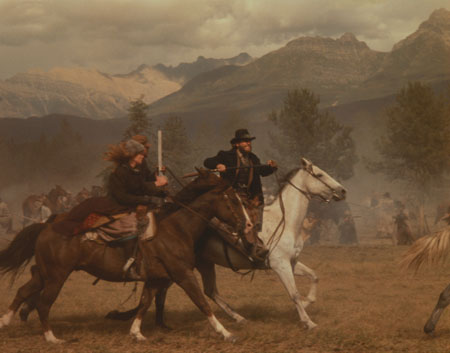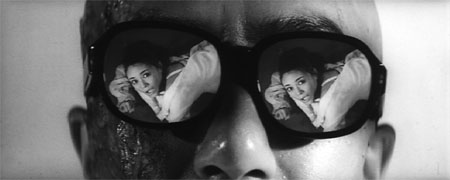Tony Kushner’s first draft of Lincoln ran over 500 pages. That film’s yet to be made, of course, as Steven Spielberg smartly decided to hone it down to a single episode, the passage of the 13th Amendment. This holiday weekend sees revivals of two restorations of films by directors who went with the opposite impulse—to go wide and long, to shoot for the Great American Epic. The scale of the productions of Michael Cimino’s Heaven’s Gate, out now on Blu-ray from Criterion, and Sergio Leone’s Once Upon a Time in America, screening at New York’s Film Forum in its “complete European release version,” are each as famously grand as the severity of the studios’ mutilation of the final cut before their initial theatrical releases.
Howard Hampton in a marvelous piece for Artforum: “The uncut Heaven’s Gate (1980) moves like a valedictory processional into the movie past—a funereal journey that waltzes across an Eastern prologue steeped in The Magnificent Ambersons (1942), then heads due West into the then-recent anti-Establishment territory of Pat Garrett and Billy the Kid (1973) and McCabe and Mrs. Miller (1971), rumbling on through the classical heroic landscape of Shane (1953) and a hundred other rugged, slightly less Arthurian oaters. Destination: a winsome, full-bore naiveté straight out of D.W. Griffith, part lingering Victorian idyll, part horse-opera Intolerance, part Birth of a Nation in reverse—the miscarriage of America’s ideals as capitalist cattle barons trample the hopes and rights of immigrants, women, and anyone stubborn or foolhardy enough to stand in their way…. Shot for shot, vista for sky-blue vista, this may be the most pictorially beautiful film to fixate on this side of Lawrence of Arabia…. And like Lawrence, it has a noticeably cavalier attitude toward history, an even sketchier approach to character psychology, and a gleeful willingness to sacrifice narrative coherence for stunning set pieces.”
More from Giulia D’Agnolo Vallan for Criterion; earlier: reviews from the New York Film Festival.
“Just as the Fistful of Dollars trilogy and Once Upon a Time in the West inflated standard Western plot beats through durational gravitas, Sergio Leone’s 1984 Once Upon a Time in America—as the title explicitly signals—lends mythological heft to the normally fleet Prohibition gangster genre,” writes Vadim Rizov at GreenCine Daily. “Like 1939’s The Roaring Twenties, it’s about American economic outsiders climbing to success with illicit booze, with former partners becoming enemies: there, James Cagney and Humphrey Bogart; here, David ‘Noodles’ Aaronson (Robert De Niro) and Max Bercovicz (James Woods). Just as in 1949’s White Heat, events are often determined and underpinned by its antihero’s sexually misdirected energy: in Heat, Cagney’s devotion to his mother, and in America, Noodles’ lifelong inability to win over Deborah (Elizabeth McGovern) frustratingly climaxing in a brutal rape just before the intermission.”
“Leone’s project was both a personal labor of love and an attempt to out-Godfather Coppola’s Godfather saga,” writes David Fear, “complete with extravagant tommy-gun slaughtering, sweeping Delancey Street—diaspora shots and some seriously chronologically skewed hopscotching between time periods…. Seen today, this rise-and-fall chronicle will make you nostalgic—not for the days of New World shtetls and Borsalino-wearing bad guys, but for an era when giants walked the earth and made excessive epics with scope, substance and a true sense of cinematic grandeur, once upon a time.”
Also in Time Out New York, Joshua Rothkopf talks about the film with Christopher Frayling, author of Spaghetti Westerns: Cowboys and Europeans from Karl May to Sergio Leone (1981). More from Daniel Guzmán (Cinespect). Update, 11/22: “As a magnum opus, Once Upon a Time in America falls just a few point tragically shy of greatness,” argues Steve Macfarlane in Slant.
In other news. Filmmaker‘s not only launched a new issue, but also a spiffy new site.
In the Los Angeles Review of Books, Jonathan Zimmerman presents “A Three Act Journey in the Land of the Screenwriting Gurus.”
“I don’t think we are witnessing the emergence of a lasting break with the old, durable Hollywood ways, but we are seeing an exciting level of playfulness.” That’s Manohla Dargis, in conversation with fellow New York Times chief film critic A.O. Scott about this season’s harvest.
Yesterday was Anna Karina Day at DC’s.
DVD/Blu-ray. “If Shochiku had a house genre in the 1950s, it was the melodrama, tinged with a little romance,” writes Chuck Stephens, reviewing Eclipse Series 37: When Horror Came to Shochiku for Criterion. “The quartet of berserk and bizarre science fiction/fantasy/horror genre masterworks the company produced in 1967 and 1968—The X from Outer Space; Goke, Body Snatcher from Hell; The Living Skeleton; and Genocide—have become legendary and sought-after crucibles of cheaply expressive special effects, unhinged flights of filmmaking fancy, and myriad topical anxieties of their day. Here are worlds of bargain-basement nightmares and genuine culture shocks, where vampires and UFOs are no stranger or more horrific than the atrocities of the Vietnam War or the disruptive energies of a brassy Western blonde in still-recovering postreconstruction Japan. Garishly designed and all the more gorgeous for it, these are deranged and largely despairing visions of a world gone out of control, most of them filled with bored, vicious people eager to tear one another apart. Each is a vividly etched example of 1960s Japanese popular culture run amok.” Take a look, too, at the trailers.
John Semley at Slant on a new box from Kino: “As freewheeling as Eisenstein‘s Strike and Battleship Potemkin may have seemed, their inventiveness is invariably tied to a larger intellectual program: the dissolution of the individual into the mass. Both released a year after Lenin’s death, they represent a culmination of the think-tank techniques of these early Soviet filmmakers, while also distinguishing themselves from the cruder agitation films of the late 1910s and early 1920s.”
“Drawing on his training in the fine arts, as well as his background working as cinematographer for renowned neorealist filmmakers like Roberto Rossellini and Vittorio De Sica, [Mario] Bava developed his own inimitable style.” At the House Next Door, Budd Wilkins reviews the Kino releases of Black Sunday (1960), Hatchet for the Honeymoon (1970), and Lisa and the Devil (1973).
Toronto. The four-day series Where Are the Films of Nicolás Pereda? opens tomorrow at TIFF Cinematheque and David Davidson‘s gathered a few related reads.
London. Stephen Dwoskin‘s final film, Age Is… (2012), screens tonight at the Tate Modern; Yusef Sayed has a brief overview of the career at Little White Lies.
Viewing. For Film Comment, Andrew Chan‘s put English subtitles on that new trailer for Wong Kar-wai‘s The Grandmaster.
And Moving Image Source presents Matt Zoller Seitz‘s video essay Feast, a Thanksgiving tribute to images of food on film.
For news and tips throughout the day every day, follow @KeyframeDaily on Twitter and/or the RSS feed. Get Keyframe Daily in your inbox by signing in at fandor.com/daily.






